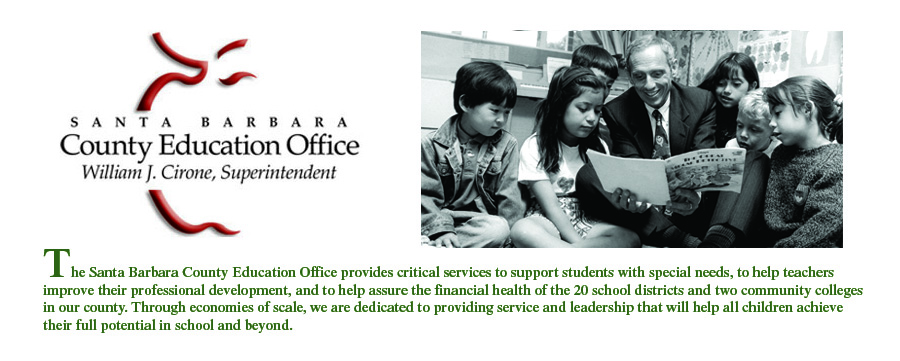By Bill Cirone, Santa Barbara County Superintendent of Schools
Newspaper Column
Recently Santa Barbara County’s Teacher of the Year, Desa Marie Mandarino, gave a wonderful speech at our annual Teachers Network Awards Banquet. Her focus was an admonition to students that “Time plus effort equals success.” Surely there is no more truthful or meaningful equation in the realm of the classroom.
Some of her other points struck me as profound on several levels. Most involved her use of words to highlight larger truths.
The reality is that sometimes words get stale and lose their power. They are shortcuts to larger meanings and can in time become substitutes for that meaning. When we tire of the word, we can lose sight of what it represents.
Desa made that point when she said she discovered there were “dreadful and ugly words that our teens did not want to hear.” Some of those words were: “homework,” “write an essay,” and even the word “student.” But clearly these are essential activities and concepts.
Her solution was to retain the underlying meaning of the word by glorifying it. What an elegant route to take. So her “students” became “scholars.” After all, that’s what a student is. But how much more glamorous it sounds. And how much more respectful the person using such a word comes to be. This only works, of course, if you mean it sincerely, and Desa is a believer to her core.
In her classroom, “homework” became “evening studies.” You can almost hear the music playing and the soft breeze wafting. Instead of a chore, those studies became positive experiences. Even her classroom “homework tray,” where assignments are dispensed, became her “Fiesta basket,” because in her mind “time plus effort” and learning itself became things that deserve a celebration.
Rather than directing her students to “write an essay,” Desa enables them to become essayists. Rather than giving oral presentations, they become orators.
“You are what you do,” Desa asserts. She insists that the young people in her classroom are not just “human beings,” but “human becomings,” and sees it as her role to guide, mentor, inspire, and teach.
It would be easy for critics to dismiss this approach as corny or contrived, but the results — and test scores — speak for themselves. Rarely will you see more engaged and enthusiastic scholars than those who grace her classrooms. That’s because Desa focuses not on stale words and concepts, but the glorious, beautiful underpinnings of those words that reveal the larger truth behind them. The scholars know the difference — teenagers are adept at spotting hollow gestures from a mile away. And it’s clear from everything Desa does and says that she means these things to her core.
I certainly do not want to belittle Desa’s masterful professionalism by focusing on just one small arrow in her quiver of exceptional instructional strategies. She is a master teacher in every sense of the word.
“The prize is in proportion to the effort,” she tells her students. Then she lives it.
The focus on re-invigorated words, however, struck me as a useful tool in many arenas. Certainly this is well known and practiced in the political arena — where weapons are dubbed “peace-keeping missiles,” wealthy people become “job creators,” and taxes become “revenue enhancements.” These techniques wouldn’t be used if they didn’t work effectively.
It seems that our public discourse could benefit from a shifting of focus, especially in these times of such strife and discord. We could all learn to replace the words that have become so polarizing, and focus instead on our shared values, goals, and humanity. Think of the strides we could make simply by reframing our arguments into positive discussions.
It’s a solution worth trying on many levels. And the prize will be in proportion to the effort, as Desa would say.

